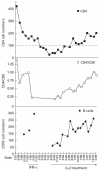Treatment of idiopathic CD4 T lymphocytopenia with IL-2
- PMID: 10337025
- PMCID: PMC1905283
- DOI: 10.1046/j.1365-2249.1999.00886.x
Treatment of idiopathic CD4 T lymphocytopenia with IL-2
Abstract
Idiopathic CD4 T lymphocytopenia (ICL) is an unusual immune defect in which there is an unexplained deficit of CD4 T cells, leading to fungal, parasitic or other serious opportunistic infections. Current treatment efforts are directed at eliminating infections. Here we describe the use of a novel treatment, subcutaneous polyethylene glycol (PEG)-IL-2 injections, in a woman with this disorder, who had chronic severe mycobacterial disease which led to repeated hospitalizations, and advancing respiratory insufficiency. For this patient, PEG-IL-2, 50 000 U/m2, has been given by weekly subcutaneous injections for 5.5 years. This treatment has resulted in marked (and still continuing) long-term immunological improvement with normalized T cell functions and increased CD4 cell numbers. She has had substantial clinical improvement with clearing of mycobacterial disease, reducing hospitalizations and improved lung functions. The improvement seen in this patient suggests that low-dose IL-2 is a safe and practical therapy, which might be useful in other subjects with this potentially serious immune defect.
Figures


References
-
- Laurence J, Siegal FP, Schattner E, Gelman IH, Morse S. Acquired immunodeficiency without evidence of infection with human immunodeficiency virus types 1 and 2. Lancet. 1992;340:273–4. - PubMed
-
- Smith DK, Neal JJ, Holmberg SD. Unexplained opportunistic infections and CD4+ T lymphopenia without HIV infection: an investigation of cases in the United States. N Engl J Med. 1993;328:373–9. - PubMed
-
- Ho DD, Cao Y, Zhu T, Farthing C, Wang N, Gu G, Schooley RT, Daar ES. Idiopathic CD4+ T lymphopenia (ICL): immunodeficiency without evidence of human immunodeficiency virus infection. N Engl J Med. 1993;328:380–6. - PubMed
-
- Spira TJ, Jones BM, Nicholson JKA, et al. Idiopathic CD4+ T lymphocytopenia—an analysis of five patients with unexplained opportunistic infections. N Engl J Med. 1993;328:86–92. - PubMed
-
- Duncan RA, Von Reyn CF, Alliegro GM, Toossi Z, Sugar AM, Levitz SM. Idiopathic CD4+ T lymphocytopenia—four patients with opportunistic infections and no evidence of HIV infection. N Engl J Med. 1993;328:393–8. - PubMed
Publication types
MeSH terms
Substances
Grants and funding
LinkOut - more resources
Full Text Sources
Other Literature Sources
Medical
Research Materials

